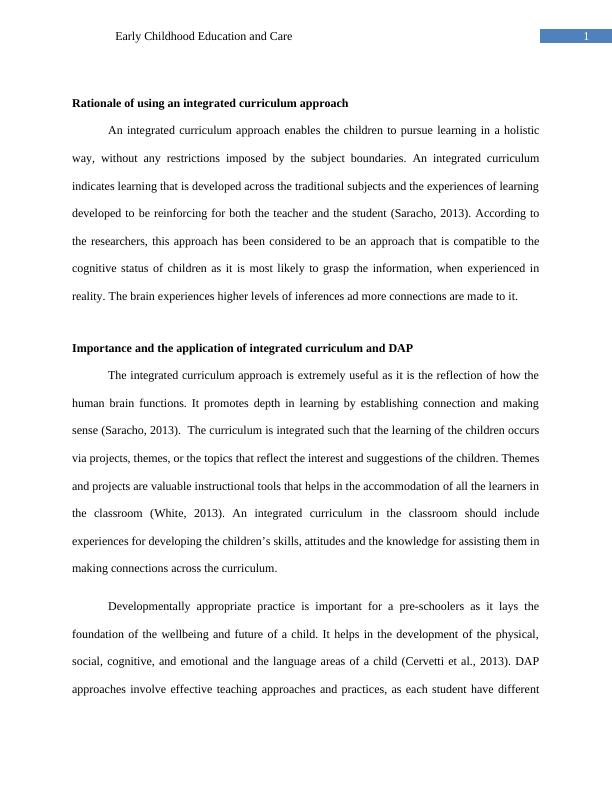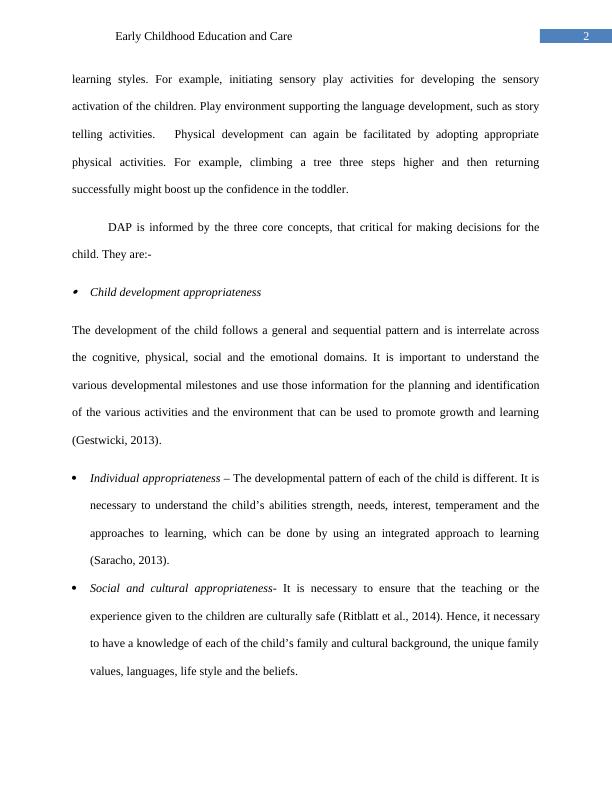Early Childhood Education and Care Using an integrated curriculum approach
Added on 2023-04-22
12 Pages2755 Words348 Views
Running head: Early Childhood Education and Care
Early Childhood Education and Care
Name of the Student
Name of the university
Author’s note
Early Childhood Education and Care
Name of the Student
Name of the university
Author’s note

1Early Childhood Education and Care
Rationale of using an integrated curriculum approach
An integrated curriculum approach enables the children to pursue learning in a holistic
way, without any restrictions imposed by the subject boundaries. An integrated curriculum
indicates learning that is developed across the traditional subjects and the experiences of learning
developed to be reinforcing for both the teacher and the student (Saracho, 2013). According to
the researchers, this approach has been considered to be an approach that is compatible to the
cognitive status of children as it is most likely to grasp the information, when experienced in
reality. The brain experiences higher levels of inferences ad more connections are made to it.
Importance and the application of integrated curriculum and DAP
The integrated curriculum approach is extremely useful as it is the reflection of how the
human brain functions. It promotes depth in learning by establishing connection and making
sense (Saracho, 2013). The curriculum is integrated such that the learning of the children occurs
via projects, themes, or the topics that reflect the interest and suggestions of the children. Themes
and projects are valuable instructional tools that helps in the accommodation of all the learners in
the classroom (White, 2013). An integrated curriculum in the classroom should include
experiences for developing the children’s skills, attitudes and the knowledge for assisting them in
making connections across the curriculum.
Developmentally appropriate practice is important for a pre-schoolers as it lays the
foundation of the wellbeing and future of a child. It helps in the development of the physical,
social, cognitive, and emotional and the language areas of a child (Cervetti et al., 2013). DAP
approaches involve effective teaching approaches and practices, as each student have different
Rationale of using an integrated curriculum approach
An integrated curriculum approach enables the children to pursue learning in a holistic
way, without any restrictions imposed by the subject boundaries. An integrated curriculum
indicates learning that is developed across the traditional subjects and the experiences of learning
developed to be reinforcing for both the teacher and the student (Saracho, 2013). According to
the researchers, this approach has been considered to be an approach that is compatible to the
cognitive status of children as it is most likely to grasp the information, when experienced in
reality. The brain experiences higher levels of inferences ad more connections are made to it.
Importance and the application of integrated curriculum and DAP
The integrated curriculum approach is extremely useful as it is the reflection of how the
human brain functions. It promotes depth in learning by establishing connection and making
sense (Saracho, 2013). The curriculum is integrated such that the learning of the children occurs
via projects, themes, or the topics that reflect the interest and suggestions of the children. Themes
and projects are valuable instructional tools that helps in the accommodation of all the learners in
the classroom (White, 2013). An integrated curriculum in the classroom should include
experiences for developing the children’s skills, attitudes and the knowledge for assisting them in
making connections across the curriculum.
Developmentally appropriate practice is important for a pre-schoolers as it lays the
foundation of the wellbeing and future of a child. It helps in the development of the physical,
social, cognitive, and emotional and the language areas of a child (Cervetti et al., 2013). DAP
approaches involve effective teaching approaches and practices, as each student have different

2Early Childhood Education and Care
learning styles. For example, initiating sensory play activities for developing the sensory
activation of the children. Play environment supporting the language development, such as story
telling activities. Physical development can again be facilitated by adopting appropriate
physical activities. For example, climbing a tree three steps higher and then returning
successfully might boost up the confidence in the toddler.
DAP is informed by the three core concepts, that critical for making decisions for the
child. They are:-
Child development appropriateness
The development of the child follows a general and sequential pattern and is interrelate across
the cognitive, physical, social and the emotional domains. It is important to understand the
various developmental milestones and use those information for the planning and identification
of the various activities and the environment that can be used to promote growth and learning
(Gestwicki, 2013).
Individual appropriateness – The developmental pattern of each of the child is different. It is
necessary to understand the child’s abilities strength, needs, interest, temperament and the
approaches to learning, which can be done by using an integrated approach to learning
(Saracho, 2013).
Social and cultural appropriateness- It is necessary to ensure that the teaching or the
experience given to the children are culturally safe (Ritblatt et al., 2014). Hence, it necessary
to have a knowledge of each of the child’s family and cultural background, the unique family
values, languages, life style and the beliefs.
learning styles. For example, initiating sensory play activities for developing the sensory
activation of the children. Play environment supporting the language development, such as story
telling activities. Physical development can again be facilitated by adopting appropriate
physical activities. For example, climbing a tree three steps higher and then returning
successfully might boost up the confidence in the toddler.
DAP is informed by the three core concepts, that critical for making decisions for the
child. They are:-
Child development appropriateness
The development of the child follows a general and sequential pattern and is interrelate across
the cognitive, physical, social and the emotional domains. It is important to understand the
various developmental milestones and use those information for the planning and identification
of the various activities and the environment that can be used to promote growth and learning
(Gestwicki, 2013).
Individual appropriateness – The developmental pattern of each of the child is different. It is
necessary to understand the child’s abilities strength, needs, interest, temperament and the
approaches to learning, which can be done by using an integrated approach to learning
(Saracho, 2013).
Social and cultural appropriateness- It is necessary to ensure that the teaching or the
experience given to the children are culturally safe (Ritblatt et al., 2014). Hence, it necessary
to have a knowledge of each of the child’s family and cultural background, the unique family
values, languages, life style and the beliefs.

3Early Childhood Education and Care
Subject web
Numeracy
1-2—3 farmyard math game
Counting the number of flying animals,
aquatic creatures, terrestrial creatures
Addition by the counting the number of
ducks
Dressing the raccoons and counting figures
Language and literacy
Matching the word cards to the animals
Story telling “two little bears”
Number of herbivores and carnivores
present
Asking the students to spell the names of
the animals
Discovery of science
Sorting out different types of animals
Sorting out the nature of the habitat.
Audio-visual display: National geography
Matching the animals with their mode of
nutrition
Zoo animals identification (4 years)
Aesthetic and Creative expression
Coloring the animals in the picture
book.
Singing “ there was a crocodile” song
Clapping with the rhythm.
Dressed up in clothes with different
animal prints
Physical development
Motor skills- collecting the cutouts
and matching the cutouts
painting different animals
Gross motor skills– Dancing with the
animal song
Mountain climbing, where each
children will have to reach the point,
where an animal has been placed.
Social development:
Singing together “here was a
crocodile”.
Dividing the class in to groups to enact
the animal drama with attires
representing different materials.
Drawing the cartoon of a mother bear,
father bear and the baby bear
Asking the each of the children about
the type of animal they love.
Subject web
Numeracy
1-2—3 farmyard math game
Counting the number of flying animals,
aquatic creatures, terrestrial creatures
Addition by the counting the number of
ducks
Dressing the raccoons and counting figures
Language and literacy
Matching the word cards to the animals
Story telling “two little bears”
Number of herbivores and carnivores
present
Asking the students to spell the names of
the animals
Discovery of science
Sorting out different types of animals
Sorting out the nature of the habitat.
Audio-visual display: National geography
Matching the animals with their mode of
nutrition
Zoo animals identification (4 years)
Aesthetic and Creative expression
Coloring the animals in the picture
book.
Singing “ there was a crocodile” song
Clapping with the rhythm.
Dressed up in clothes with different
animal prints
Physical development
Motor skills- collecting the cutouts
and matching the cutouts
painting different animals
Gross motor skills– Dancing with the
animal song
Mountain climbing, where each
children will have to reach the point,
where an animal has been placed.
Social development:
Singing together “here was a
crocodile”.
Dividing the class in to groups to enact
the animal drama with attires
representing different materials.
Drawing the cartoon of a mother bear,
father bear and the baby bear
Asking the each of the children about
the type of animal they love.

End of preview
Want to access all the pages? Upload your documents or become a member.
Related Documents
Critiquing Documentation And Curriculumlg...
|13
|3585
|34
Early Childhood Education and Carelg...
|13
|3875
|149
Assignment about Early Brain Developmentlg...
|9
|1328
|26
Program Planning in Early Childhood Education and Carelg...
|12
|2274
|496
Personal Philosophy of Early Childhood Educationlg...
|5
|815
|77
Early Childhood Attachment and Educationlg...
|6
|1236
|158
